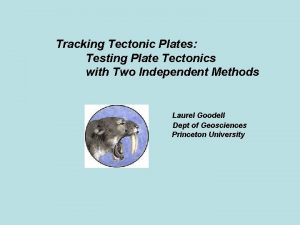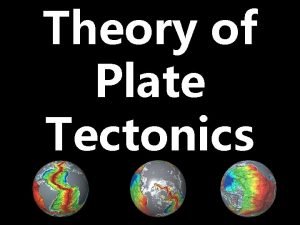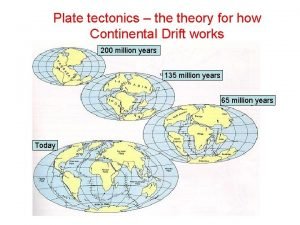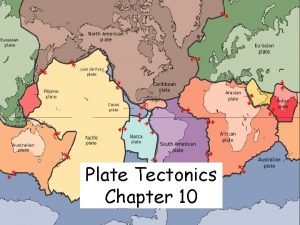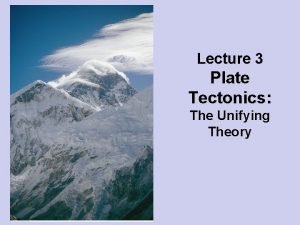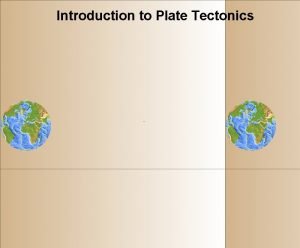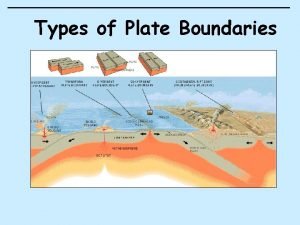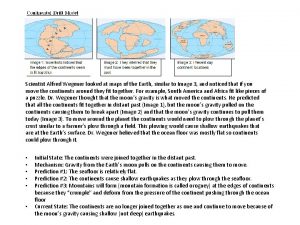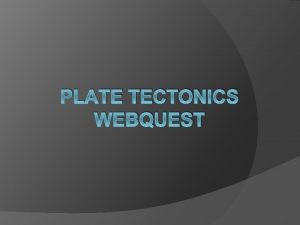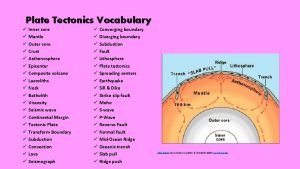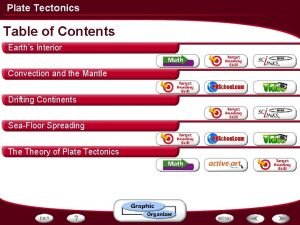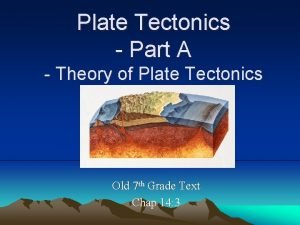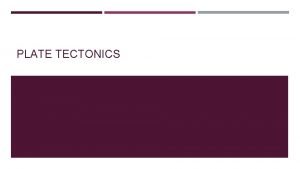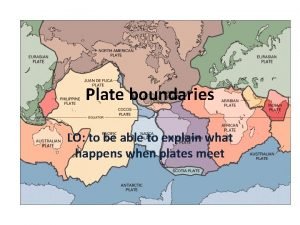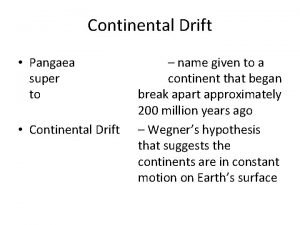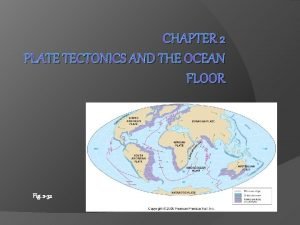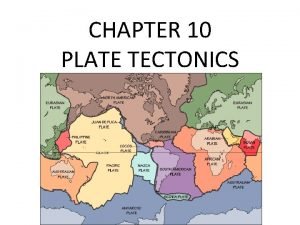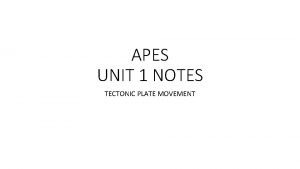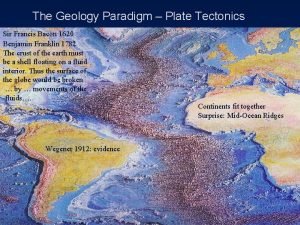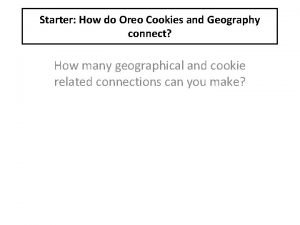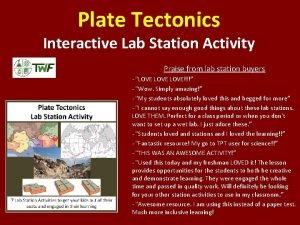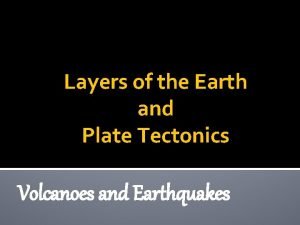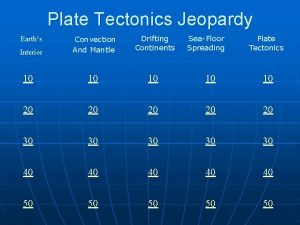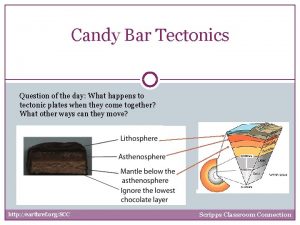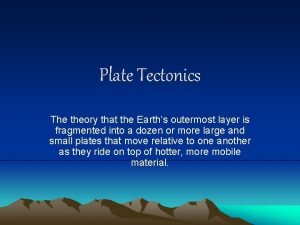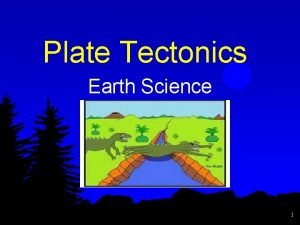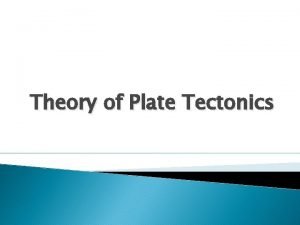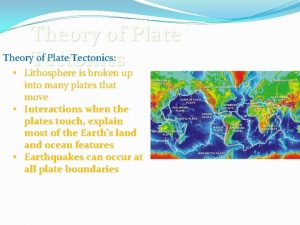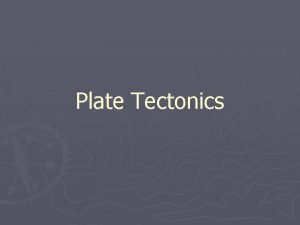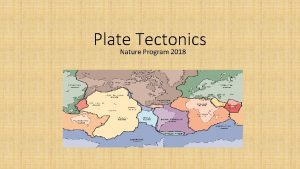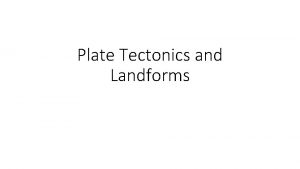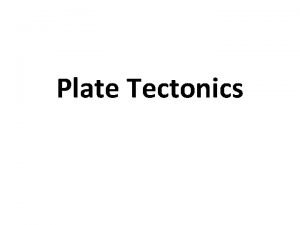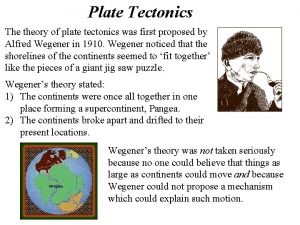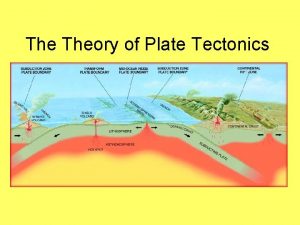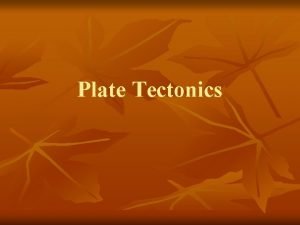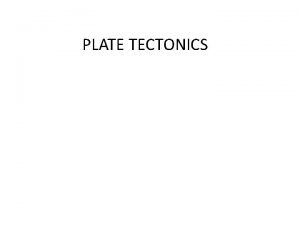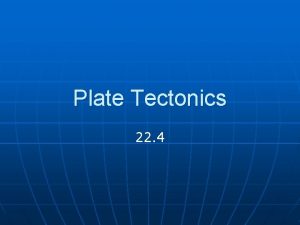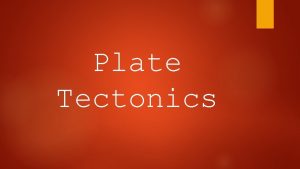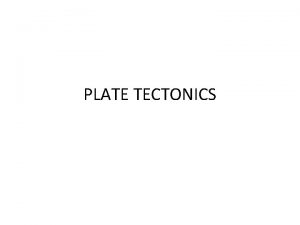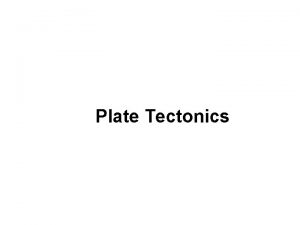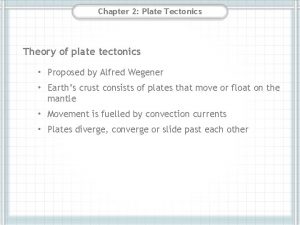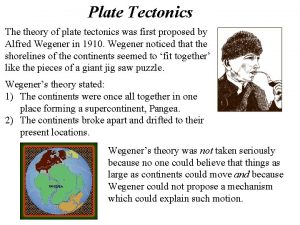Plate Tectonics Plate Tectonics Theory of Plate Tectonics


































- Slides: 34

Plate Tectonics

Plate Tectonics • Theory of Plate Tectonics is a theory that describes the formation, movements, and interactions of Earth’s lithospheric plates that move on the asthenosphere.

Theory of Plate Tectonics • Theory of Plate Tectonics explains why earthquakes and volcanoes are likely to occur in particular locations and how new crust forms along the ocean floor.

Earthquakes and volcanic activity occur primarily at the location of plate boundaries. – Plate boundaries are where 2 plates are pushing toward, pulling away, or sliding past each other. The strain and friction causes fractures in the earth, where earthquakes occur and where the fractures allow molten rock to flow to the surface.

Evidence for plate tectonics was also found in igneous rocks which recorded the direction of Earth’s magnetic field.

• Mid-ocean ridge is a long chain of volcanic mountains on the ocean floor with a deep central valley. The mid-ocean ridge always shows the magnetic orientation of the North and South poles.

Mid-ocean Ridge –A pattern of bands on either side of the mid-ocean ridge show the changes in magnetic orientation.

Mid-ocean Ridges – Rocks at the center of the mid-ocean ridge are the youngest. (so the farther the rocks are from the mid-ocean ridge the rocks are). older – Mid-ocean ridges are boundaries where plates are moving apart.

3 Main Hypothesis Which Cause of Plate Movement: • Mantle Convection, • Ridge Push, and • Slab Pull

Mantle Convection: 1. Mantle Convection - the transfer (convection) of heat from Earth’s inner and outer cores moves the plates (like a convection belt)

Ridge Push 2. Ridge Push – occurs at the Mid-ocean Ridges - The hot molten magma rises up at the mid-ocean ridges and as it cools and hardens into a denser rock, the rock pushes out and slides down the ridge, allowing more new hot molten material to flow out of the mid-ocean ridge.

Slab Pull - Scientists believe this Slab Pull is the greater factor out of the three theories. 3. Slab Pull – occurs at a subduction boundary. - The denser, heavier plate sinks underneath the other less dense plate. The edge of the subduction plate is much colder and heavier than the mantle, so it continues to sink and pull the rest of the plate along down with it.

CONTINENTAL DRIFT • Alfred Wegener proposed a hypothesis called Continental Drift which said the continents have drifted, or moved from one location to another over time.

Continental Drift was proven by: • The shapes of the continents seem to match up (fit together like puzzle pieces)

Continental Drift was proven by: • Certain fossils are on different continents – Example: Mesosaurus – reptile that lived about 270 mya, fossils found only in parts of South America and Africa – could have only happened when the 2 continents were once joined).

Continental Drift was proven by: • Mountain chains found on 2 continents and would have matched up if the continents were joined. – Example: Appalachian Mountains – run along the eastern coast of US and through Great Britain.

Pangaea – the giant supercontinent that existed about 200 mya.


TYPES OF PLATE BOUNDARIES • There are 3 main types of plate boundaries: – Divergent Boundary, – Convergent Boundary, and – Transform Boundary


Divergent Boundary

Divergent Boundary • Plates are moving apart • Occurs at Mid-ocean Ridges and at Rift Valleys (seafloor spreading) – Rift valley = deep valleys at the center of a midocean ridge. • Volcanic activity (underwater) and earthquakes take place along this boundary. – Hot springs also come up from hydrothermal vents on the ocean floor.

Divergent Boundary • Mid-Atlantic Ridge (Atlantic Ocean)

Divergent Boundary • East Pacific Rise (Pacific Ocean) • Transform faults run along the mid-ocean ridges

Convergent Boundary • Plates are moving toward each other. • 2 Types of Convergent Boundaries – Subduction – Collision

Convergent Boundary • Subduction occurs at: – ocean to ocean plate moving toward each other – Ocean to continental plates moving toward each other – Oceanic crust is denser than continental crust, so oceanic crust will subduct underneath the continental plate • Deep sea trenches are formed • Volcanic island arcs are formed • Earthquakes occur

Convergent Boundary - Subduction • Islands of Indonesia (ocean to ocean) • Mariana Islands (ocean to ocean) • Mariana Trench (Pacific plate moving underneath the Philippine Plate)

Convergent Boundary - Subduction • Mariana Islands – Philippine and Pacific plates colliding (ocean to ocean)

Convergent Boundary • Collision Boundary occurs at: – Continental to continental plate moving towards each other • Builds high mountain chains • Earthquakes occur along these boundaries

Convergent Boundary - Collision

Convergent Boundary - Collision • Our Appalachian Mountains were also formed this way long ago, but are not currently being formed. (rounded mountain tops – been weathered and eroded down)

Convergent Boundary - Collision • Himalaya Mountains (sharp and jagged peaks)

Transform Boundary • 2 plates are sliding past each other. – Earthquake activity occurs here

Transform Boundary • San Andreas Fault (in California) – Movement isn’t the same along all parts of the fault. Some parts can move up to 5 cm/yr, while others haven’t moved in over a century. • North Anatolian Fault (in Turkey) • Fracture zones along mid-ocean ridges
 Convergent boundary divergent boundary transform boundary
Convergent boundary divergent boundary transform boundary Continental drift vs plate tectonics theory
Continental drift vs plate tectonics theory Evidence of the theory of plate tectonics
Evidence of the theory of plate tectonics The plate tectonics theory states that
The plate tectonics theory states that Convergent plate boundary
Convergent plate boundary Summarize the theory of plate tectonics
Summarize the theory of plate tectonics Lithosphere definition
Lithosphere definition Unifying theory of plate tectonics
Unifying theory of plate tectonics Theory of plate tectonics
Theory of plate tectonics Plate tectonics vs continental drift
Plate tectonics vs continental drift Convergent boundary
Convergent boundary Compare continental drift and plate tectonics
Compare continental drift and plate tectonics Plate tectonics webquest pdf
Plate tectonics webquest pdf Plate tectonics vocabulary
Plate tectonics vocabulary Seafloor spreading material at trenches
Seafloor spreading material at trenches Plate tectonics definition
Plate tectonics definition Driving force of plate tectonics
Driving force of plate tectonics Concept map plate tectonics
Concept map plate tectonics Arthur holmes contribution to plate tectonics
Arthur holmes contribution to plate tectonics Mantle magma
Mantle magma Plate boundaries
Plate boundaries Edible plate boundaries
Edible plate boundaries Pangaea
Pangaea The ocean floor revealing plate tectonics
The ocean floor revealing plate tectonics Fossils as evidence of continental drift
Fossils as evidence of continental drift Plate tectonics apes
Plate tectonics apes Francis bacon plate tectonics
Francis bacon plate tectonics Oreo cookies and plate tectonics answer key
Oreo cookies and plate tectonics answer key Plate tectonics interactive lab
Plate tectonics interactive lab Convergent plate boundary
Convergent plate boundary Oreo cookies plate tectonics
Oreo cookies plate tectonics Plate tectonics game board
Plate tectonics game board Candy bar tectonics
Candy bar tectonics Plate tectonics
Plate tectonics Plate tectonics
Plate tectonics


